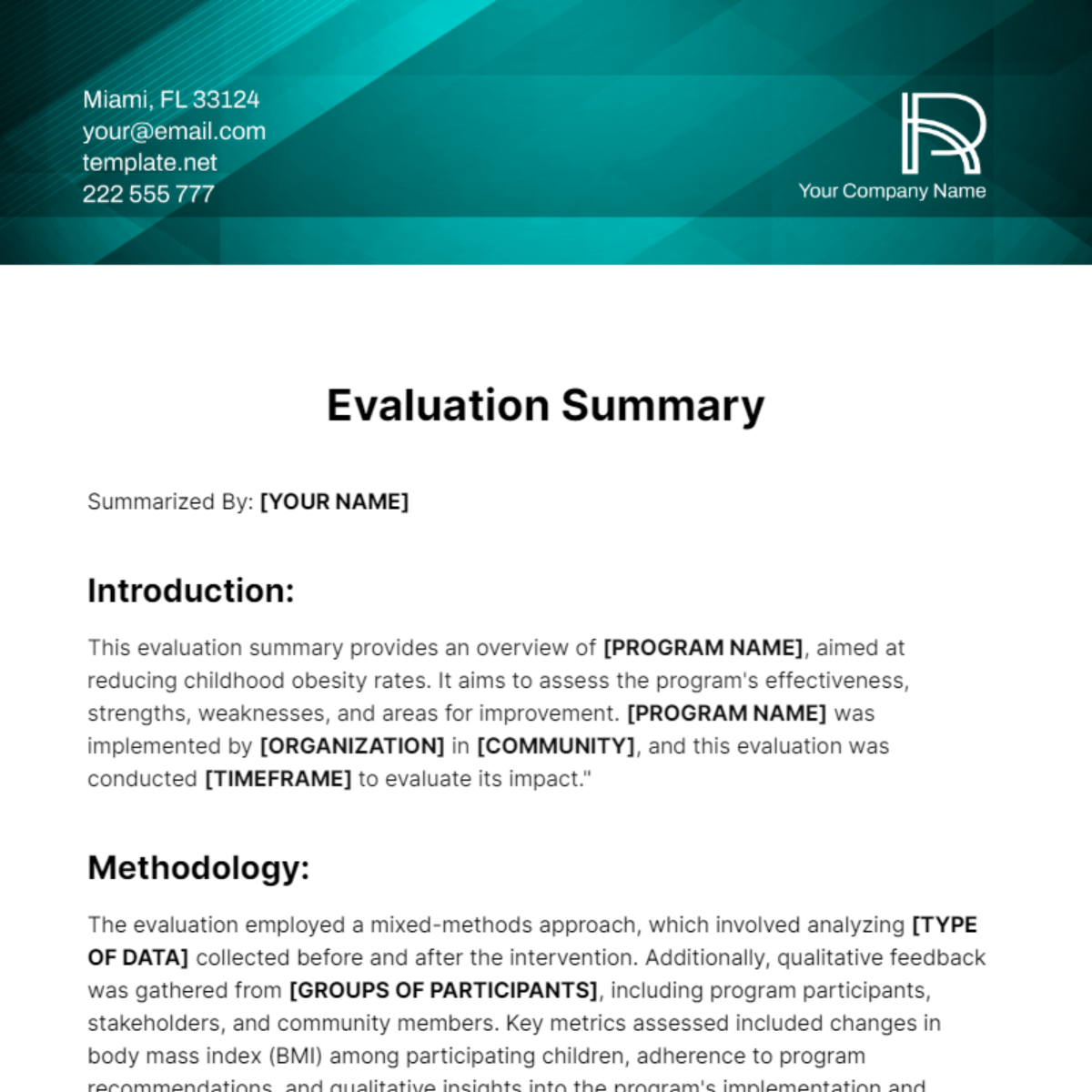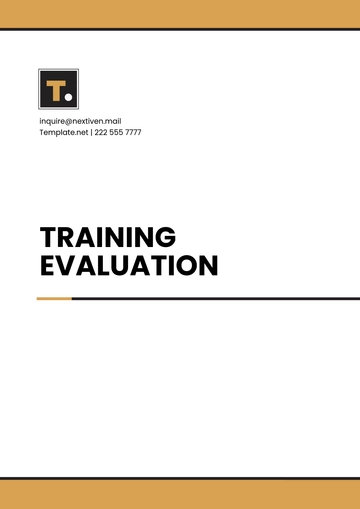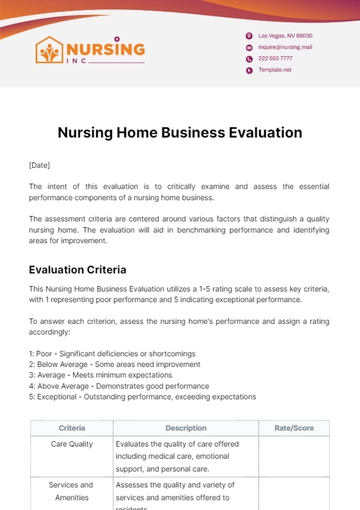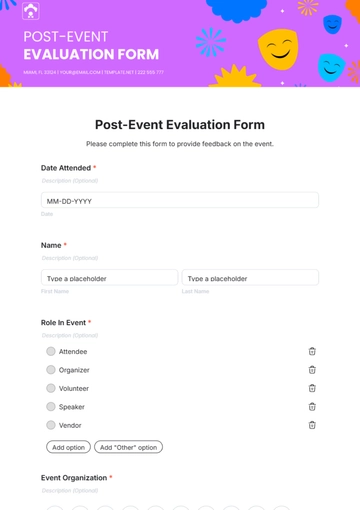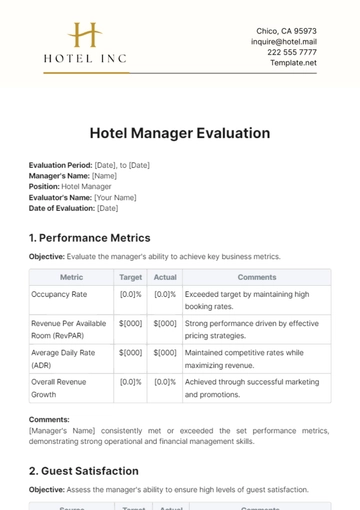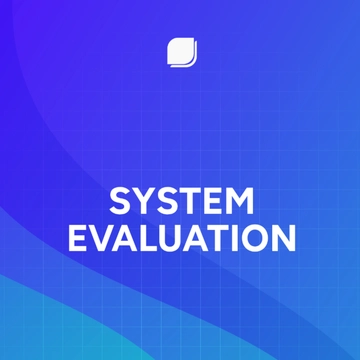Evaluation Summary
Summarized By: [YOUR NAME]
Introduction:
This evaluation summary provides an overview of [PROGRAM NAME], aimed at reducing childhood obesity rates. It aims to assess the program's effectiveness, strengths, weaknesses, and areas for improvement. [PROGRAM NAME] was implemented by [ORGANIZATION] in [COMMUNITY], and this evaluation was conducted [TIMEFRAME] to evaluate its impact."
Methodology:
The evaluation employed a mixed-methods approach, which involved analyzing [TYPE OF DATA] collected before and after the intervention. Additionally, qualitative feedback was gathered from [GROUPS OF PARTICIPANTS], including program participants, stakeholders, and community members. Key metrics assessed included changes in body mass index (BMI) among participating children, adherence to program recommendations, and qualitative insights into the program's implementation and perceived impact.
Quantitative Analysis:
Reduction in Childhood Obesity Rates:
Pre-intervention data indicated that [PRE-INTERVENTION PERCENTAGE]% of participating children were classified as obese.
Post-intervention assessment revealed a reduction in childhood obesity rates by [REDUCTION PERCENTAGE]%, with only [POST-INTERVENTION PERCENTAGE]% of children classified as obese.
This reduction demonstrates a significant positive impact of the intervention on childhood obesity rates within the community.
Adherence to Program Recommendations:
Program Component | Adherence Rate |
|---|
Healthy Eating Workshops | [HEALTHY EATING WORKSHOP ADHERENCE]% |
Physical Activity Sessions | [PHYSICAL ACTIVITY SESSION ADHERENCE]% |
Nutritional Counseling | [NUTRITIONAL COUNSELING ADHERENCE]% |
The table above illustrates high adherence rates among participants to various program components, indicating strong engagement and compliance with program recommendations.
Qualitative Feedback:
Perceived Impact:
Feedback from [PARTICIPANTS] and [PARENTS] emphasized improvements in dietary habits, increased levels of physical activity, and enhanced knowledge about healthy lifestyles.
Parents reported positive changes in their children's attitudes toward nutrition and physical activity, indicating a shift toward healthier behaviors within families.
Community Engagement:
Stakeholders expressed satisfaction with the level of [ENGAGEMENT TYPE] and collaboration throughout the program.
[SCHOOL NAME] actively supported and promoted program initiatives, contributing to its success."
Strengths:
Comprehensive Approach: The [PROGRAM NAME] multi-component approach, including educational workshops, physical activities, and nutritional counseling, addressed various aspects contributing to childhood obesity.
Community Collaboration: Strong collaboration with local stakeholders and community organizations facilitated program implementation and sustainability.
Positive Participant Feedback: High levels of participant adherence and positive qualitative feedback indicate the program's effectiveness in promoting [PROGRAM OUTCOMES].
Areas for Improvement:
Long-Term Sustainability: [STRATEGIES] should be developed to ensure the long-term sustainability of program initiatives beyond the intervention period.
Targeting At-Risk Populations: Efforts to target and engage at-risk populations, such as [AT-RISK POPULATIONS], could further enhance the program's impact.
Continuous Evaluation: Implementing mechanisms for ongoing evaluation and feedback collection will facilitate continuous improvement and adaptation to community needs.
Conclusion:
The [PROGRAM NAME] has shown promising results in reducing childhood obesity rates and promoting healthy lifestyles within the [COMMUNITY]. By addressing various factors contributing to obesity through a comprehensive approach and fostering strong community collaboration, the program has made significant progress in improving the health and well-being of children and families. Continued efforts to sustain and expand program initiatives will be crucial for achieving long-term impact and effectively addressing the complex challenges of childhood obesity
Summary Templates @ Template.net
